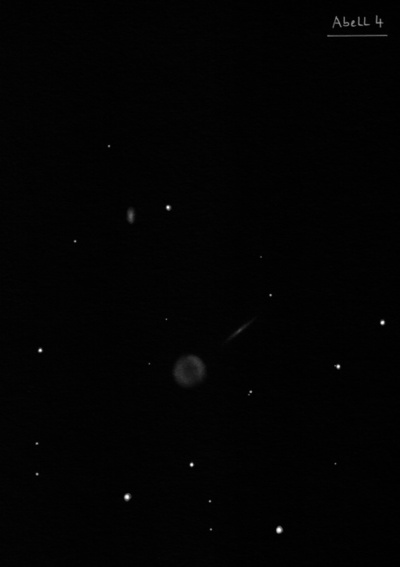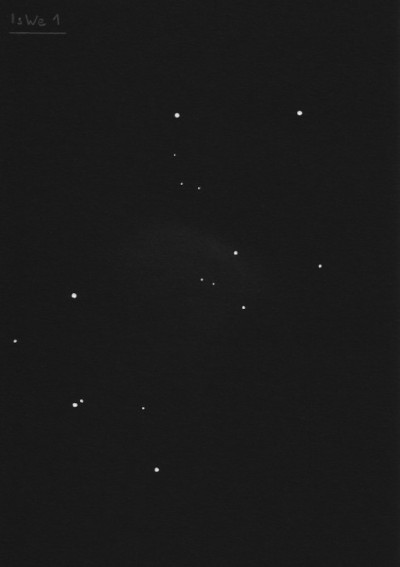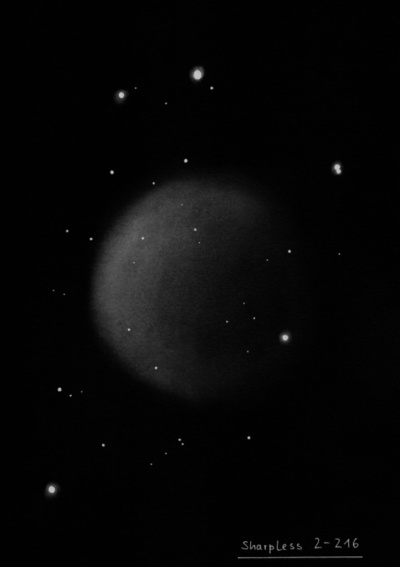A prominent, in our partly circumpolar constellation of the northern sky, with four stars brighter than 3mag. It lies in the Milky Way between Charioteer and Andromeda, to the left below the Kasiopei pattern. The rich star field forms one of the spiral arms of our Galaxy, the Perseus Arm. Perseus is rich in objects typical of the Milky Way constellation, such as open star clusters and emission nebulae. But it also contains some interesting galaxies. Messier objects are represented in the open cluster M34 and the planetary nebula M76. The h / χ Perseus binary cluster - NGC 869 & NGC 884 and the binocular-suitable Alpha Perseus mobile group, one of the closest open clusters to our Solar System, also catch our attention. The California Gas Nebula is also well known, although spotting it visually is not so easy for beginners.
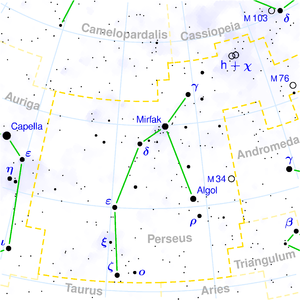 The Milky Way enters the constellation as a narrow path through the stars φ, 4 and 9 Perseus. However, if you go to some of the dimmer locations where even very faint stars are visible, you'll see much more detail. To the north of the Stock 2 cluster, a narrow dark bay cuts into the Milky Way, extending all the way to the star ε Cas, which transitions into a larger circular dimming towards the east. This forms a relatively sharp nebulous outlier of the Milky Way, disappearing somewhere near a pair of unnamed fourth-magnitude stars at the boundary of Giraffe, Cassiopeia and Perseus. The main stream continues between the open cluster M34 and the open cluster Melotte 20 at α Perseus, which contains several white sparkly stars. In the triad, the cluster breaks up into a belt of several dozen stars of varying brightness that almost covers the entire field of view. The brightest of these are ε, ψ, 29, 30, 31 and 34 Perseus. A very faint edge of the oval-shaped Milky Way is still between the ζ and ε stars of Perseus and is bounded by dark nebulae.
The Milky Way enters the constellation as a narrow path through the stars φ, 4 and 9 Perseus. However, if you go to some of the dimmer locations where even very faint stars are visible, you'll see much more detail. To the north of the Stock 2 cluster, a narrow dark bay cuts into the Milky Way, extending all the way to the star ε Cas, which transitions into a larger circular dimming towards the east. This forms a relatively sharp nebulous outlier of the Milky Way, disappearing somewhere near a pair of unnamed fourth-magnitude stars at the boundary of Giraffe, Cassiopeia and Perseus. The main stream continues between the open cluster M34 and the open cluster Melotte 20 at α Perseus, which contains several white sparkly stars. In the triad, the cluster breaks up into a belt of several dozen stars of varying brightness that almost covers the entire field of view. The brightest of these are ε, ψ, 29, 30, 31 and 34 Perseus. A very faint edge of the oval-shaped Milky Way is still between the ζ and ε stars of Perseus and is bounded by dark nebulae.
Algenib (α Per) - Other names for it are Mirfak or Marfak. This yellow-white supergiant with an apparent magnitude of 1.8 is the brightest star in the constellation. With an absolute luminosity 5800 times greater than that of the Sun, it is located 390 light-years away.
Algol (β Per) - It is the most famous eclipsing variable star - it is the main representative of eclipsing variable stars with a subgroup of Algol type. Sometimes it is referred to as the "winking demon", which is related to its representation as the eye of Medusa. It was also depicted this way in ancient Greece, but there are no records proving that anyone noticed its light changes at that time. It was first observed by Italian astronomer Geminiani Montanari from Bologna in 1667, making it the only known variable star in the Middle Ages. Its true nature was correctly recognized by English astronomer John Goodrick in 1782.
ζ Per - A binary star in an interesting setting. The companion, with a magnitude of 9.5, is located at a distance of 12.9" from the main pale blue component with a brightness of 2.9 magnitude, and there are two other stars nearby in the same field of view. The first star, with a magnitude of 11, is located at a separation of 33", while the second star, with a magnitude of 9.5, is at a distance of 94". It is located 750 light-years away. The closest star shares a common proper motion with the main component.
ε Per - The binary star, with a brightness companion of 8.1 magnitude, is located at a distance of 8.8" from the primary component (2.9 magnitude). The primary component is 2,500 times brighter than our Sun. It can be resolved with a telescope with a 6cm objective diameter. It is located 640 light-years away.
Miram (η Per) - Astronomical text translation:
A very easily distinguishable pair with magnitudes of 3.8 and 8.5 at a separation of 28.3". It resembles the well-known double star Albireo, as its components have a golden-blue contrast. 66" almost west of the main component, there is a close double star composed of components with magnitudes of 10mag and 10.5mag, which is likely part of the η Per system. A dozen fainter stars form a small star cluster around this system.
NGC 869
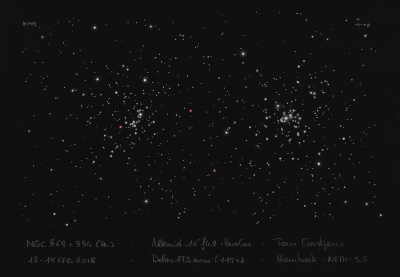
Hipparchus catalogued the Double Cluster about 130 BC and Ptolemy copied it into his Almagest: "At the tip of the right hand [of Perseus] and nebulous [or misty]." Giovanni Battista Hodierna (1654) resolved the double cluster into stars. William Herschel found NGC 869 = H VI-33 on 1 Nov 1788 (sweep 877) and recorded "A very beautiful brilliant cluster of large stars, very rich. The place taken is the most compressed part of it, which is not in the middle; the middle of it contains a vacancy".
200/250mm - 8" this is the western component of the "double cluster". Very bright, large, about 30' diameter. Very rich with about 100 stars resolved, includes several bright mag 6.5-7.0 stars in the center. Forms a pair with NGC 884 at edge of 100x field.
400/500mm - 17.5" (10/25/97): this is the brighter and richer western member of the famous "double cluster". Includes a mag 6.6 star near the center and a mag 6.7 star 2.5' NNE. Close following the mag 6.6 star is a neat parabolic group of five stars opening towards the star. On the west side of this star is a rich group of ~20 stars mostly arranged in an incomplete ring. A faint curving string of stars from the mag 6.7 star leads to the parabolic quintet. The 20' field at 220x has too many stars to count, but probably has ~200 stars.
Naked-eye - (11/13/07): I noticed that the Double Cluster was clearly resolved into two "clumps" naked-eye.
Notes by Steve Gottlieb
M 76
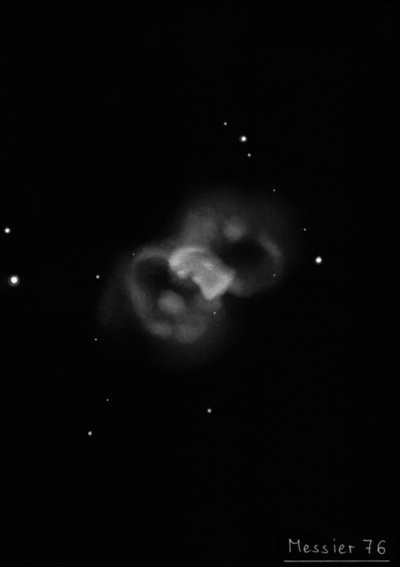
William Herschel discovered NGC 651 = H I-193 on 12 Nov 1787 (sweep 780) and recorded "Two close together; both vB, their nebulosities run into each other. Distance of their centers 1 1/2' or 2' from sp to nf." As one was M76 he assigned one new number. Dreyer assigned NGC 650 to M76 and NGC 651 to H I-193 (following of the double nebula).
300/350mm - 13.1" SW end is brighter while the NE end is slightly curved. Boxy appearance with a dark center.
400/500mm - 17.5" part of NGC 650 = M76, see description for NGC 650.
Notes by Steve Gottlieb
M 34
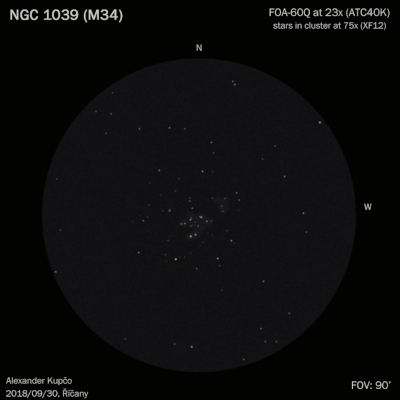
Giovanni Hodierna probably discovered M34 = NGC 1039 = h248 around 1654, though there is some doubt on his intended object. Charles Messier found M34 again on 25 Aug 1764, and is generally credited with the discovery. William Herschel described M34 on 17 Oct 1786 (sweep 614) as "a cl of scattered L stars, considerably rich." John Herschel called it a "fine cluster, about 20 st 9 10...11m and as many less. Fills field, coarsely scattered."
300/350mm - 13.1" (12/22/84): about 100 stars in a 30' diameter. Very bright, very large, many double stars, three main curved lanes. Includes a bright double star h1123 = 8.0/8.0 at 20". Naked-eye object in fairly dark sky.
600/800mm - 24" (12/28/13): gorgeous low power field with 21mm Ethos (125x; 49' diameter). The cluster roughly extends 35' with a much richer and brighter core of ~12'-15' that contains a large number of mag 8-10 stars. Several of the brighter stars appear as wide doubles or in chains. A long string of stars is on the south side of the core, extending towards the southeast. Other chains extend north and east out of the core. Several doubles were identified using the chart in Stoyan's "Atlas of the Messier Objects". O? 44 is a challenging mag 8.5/9.0 pair at 1.4" that just resolved at 225x and better at 300x. Another 8th mag star (C component) is widely separated at 86". h2154 is a 9.5/10.9 pair at 10" on the SW side and h1123 is a very wide 20" pair of mag 8.4 star. Also in the core is ES 1506, a challenging mag 8.9/14 pair at 7" and h2155, a very wide 8.3/10.3 pair at 17" on the NE side. PN Abell 4 lies 38' ESE of center.
Notes by Steve Gottlieb
NGC 1499
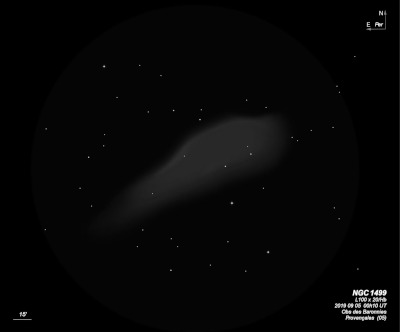
13x80mm (1/13/07): excellent view in my 80mm finder using a 24mm Panoptic and an H-beta filter as a huge, elongated bar of fairly high contrast stretching across the field. The glow is generally brightest in the broad middle section between Xi Persei and the 6th magnitude star off the central north side. The nebula noticeably tapers towards the southeast end as the northern side of this end squeezes inward. Similarly, the northwest end also tapers as the northern boundary narrows towards the southern side.
16x80mm (7/27/84): very large and faint, very elongated WNW-ESE, sharper and brighter on WNW edge, very low surface brightness. Improved contrast with an H-beta filter.
15x50mm IS binoculars (8/27/11): very faintly visible as a large, elongated glow near Xi Persei using a pair of 2" H-beta filters over the objectives.
E.E. Barnard discovered NGC 1499, the California Nebula, on 3 Nov 1885 while searching for comets with the 6-inch Cooke Equatorial refractor at Vanderbilt University Observatory. In the Sidereal Messenger (Vol 5, p27), he reported "this requires the lowest power and cannot be seen by direct vision. It is only by directing the vision slightly to one side of its place that it is pssible to see it, then flashes out feebly." The NGC position is near the following end.
Simon Archenhold produced the first photograph on 27 Oct 1891. He quickly published an article with a sketch of the outline (nearly 2?) and apparently felt it was too large photographically to be identical to Barnard's intended object. Barnard responded in an 1894 article that he discovered this object visually and published a photographed taken in 1895 with the Willard lens in Astrophysical Journal, 2, 350.
300/350mm - 13.1" (1/18/85): definite contrast gain with H-beta filter as only the section NW of Xi was definite using a Daystar 300 filter (siimlar to UHC), but the H-beta shows the full extent easily.
400/500mm - 17.5" (1/16/02): Despite its reputation as a challenging target, this was an easy, fascinating object at 64x with a H-beta filter. The California Nebula is HUGE and extended a full two eyepiece fields even using a 31 Nagler for a total length of over 2.5 degrees and with a varying width of 15'-30', extended WNW-ESE. The E-W border is well-defined with a filter, particularly in the general vicinity of Xi Persei (middle of three naked-eye stars in the leg of Perseus collinear with the Pleiades) on the southern border and a long straight stretch on the northern edge. Along the northern edge, there is some filamentary, wispy structure similar to the view of the Veil nebula in a small scope!
The nebulosity is weaker and more disorganized, though, close to the preceding and following ends. The nebula tapers towards the eastern end where there are some additional brighter streaks and dark intrusions near a group of stars. Portions of the central region are clearly fainter with no evident structure. At the west end the structure is also chaotic with an irregular mix of weak nebulosity and darker voids. There is much to view here even at 64x, and I spent 30 minutes scanning the entire length for structure.
17.5" (10/28/89): the California Nebula requires very low power and visibility is best using an H-beta filter. At 82x appears very large, faint, very elongated, irregular low surface brightness with darker lanes and some wispy structure along the edges. The most well-defined section of the border is near a mag 8.5 star bordering the southern edge. Located roughly 30' N of mag 4.0 Xi Persei.
Notes by Steve Gottlieb
NGC 1275
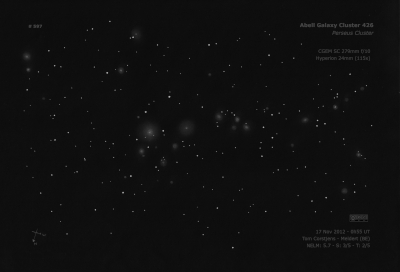
William Herschel discovered NGC 1275 = H II-603 = h293 on 17 Oct 1786 (sweep 614) and recorded "pretty bright, stellar [nebula], or a pretty considerable star with a small, vF chevelure." William's position was 1.5' too far south. John Herschel made a single observation on 18 Sep 1828 (sweep 182) and measured an accurate position. NGC 1275 was observed by Lord Rosse's assistant Johnstone Stoney on 16 Dec 1848. He noted "A multitude of nebs. knots in the neighborhood, principally preceding; counted 15; many more."
Heinrich d'Arrest observed the cluster on 14 Feb 1863 (discovering NGC 1267, 1268, 1270, 1272, 1273 and 1278) and described NGC 1275 as a "nebula duplex", the second component being NGC 1278 about 3' NE, so d'Arrest was the first to observe NGC 1278. But he wasn't sure which of the two nebulae was NGC 1275 (H. II-603), so reported his observation of NGC 1275 as new and noted for NGC 1278: "II 603? [h]293?". John Herschel credited d'Arrest with the discovery of GC 675 (later NGC 1278), but Dreyer thought WH discovered NGC 1278 and he mistakenly assigned d'Arrest's discovery to NGC 1275. Steinicke agrees (personal e-mail) that Dreyer reversed the discovery credits and descriptions for NGC 1275 and NGC 1278 in the NGC and concludes:
NGC 1275 = II 603 = h 293 = GC 674, discovered by WH on 17 Oct 1786 and observed by d'Arrest on 14 Feb 1863. NGC 1278 = GC 675, discovered by d'Arrest on 14 Feb 1863 and independently by Bigourdan on 22 Oct 1884 (IC 1907).
NGC 1275 contains a Sy2 nucleus and is one of the 6 original galaxies studied by Seyfert in his seminal 1943 paper "Nuclear Emission in Spiral Nebulae". It is a powerful radio source (Perseus A)
100/150mm - 6" (10/24/87): extremely faint and small, round. Used a 6" mask on the 17.5".
200/250mm - 8" (1/1/84): faint but not difficult, small, slightly elongated, small bright core.
300/350mm - 13.1" (1/28/84): fairly bright, fairly small, small bright core.
400/500mm - 17.5" (10/24/87): fairly bright, fairly small, oval ~E-W, small bright core. NGC 1275 is a Seyfert galaxy and is the largest and brightest member of AGC 426. Surrounded by a swarm of faint galaxies in the core including NGC 1272 5.2' WSW, NGC 1273 4.4' WNW, NGC 1274 2.6' NW, NGC 1277 3.7' NNE, NGC 1278 3.3' NNE, NGC 1279 2.8' SE, NGC 1281 7.8' NNE.
600/800mm - 24" (2/13/18): at 375x; bright, fairly large, slightly elongated WNW-ESE, ~1.6'x1.3'. Divided into three distinct zones; sharply concentrated with a strong bright core, a prominent quasi-stellar nucleus and a halo that gradually fades out. Similar or slightly smaller in size to NGC 1272, but with a higher surface brightness core/nucleus. A mag 13.8 star is just off the NW side. A dozen members of AGC 426 were logged within 5' of NGC 1275! The closest is PGC 12441, 1.5' NE of center.
Notes by Steve Gottlieb
NGC 1545
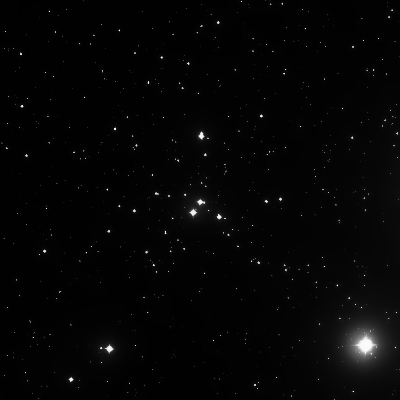
William Herschel discovered NGC 1545 = H VIII-85 on 28 Dec 1790 (sweep 989) and recorded "a coarsely scattered cluster of large stars, pretty rich." His position corresponds with the brightest star in the cluster.
200/250mm - 8" about two dozen stars in the cluster. The three brightest stars are mag 7.5-8.5. Includes chains of faint stars with double star ?519 = 7.9/9.4 at 18" at the north edge.
400/500mm - 17.5" (12/28/94): about 50 stars scattered evenly over a 20' field with no dense areas or central concentration. A pretty pair of mag 7/8 stars are near the center (South 445 = 7.3/8.2 at 72") with a blue mag 9 star to the west (SAO 24549) forming an isosceles triangle. A number of mag 11/12 stars are arranged in a curving stream oriented SW-NE which passes through the bright pair. At the north side of the cluster is a pretty colored pair ?519 = 7.9/9.4 at 18". Off the east side is a small circular group of five faint stars and one brighter star in a clump.
Notes by Steve Gottlieb
NGC 1528
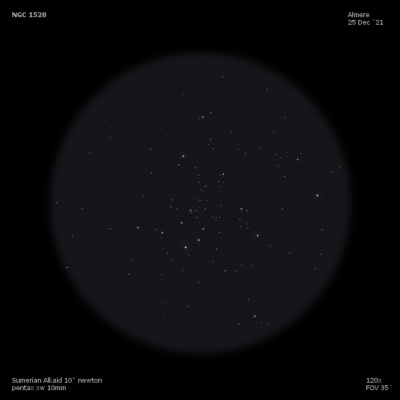
William Herschel discovered NGC 1528 = H VII-61 on 28 Dec 1790 (sweep 989) and described "a beautiful cluster of large stars, very rich, and considerably compressed, about 15' diameter." His position is near the center of this cluster.
300/350mm - 13.1" (1/18/85): 80-100 stars in a 20' diameter. There are three bright stars on the west side including mag 8.5 SAO 24496 and mag 9.0 SAO 24501, includes many faint stars. Extremely faint naked-eye object!
Notes by Steve Gottlieb
NGC 1342
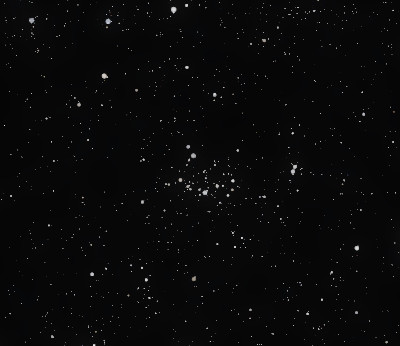
William Herschel discovered NGC 1342 = H VIII-88 = h301 on 28 Dec 1799 (sweep 1092) and described "a cluster of coarsely scattered large stars, about 15' diameter." His position is accurate.
200/250mm - 8" bright, large, scattered, consists of mag 8 stars and fainter.
400/500mm - 17.5" (12/23/92): about 100 stars mag 9-14 in 15' diameter, scattered in chains and loops. Two mag 8 stars off the NE side are probably field stars, a nice double star is at the west end. There are several striking star lanes at low power including a long stream oriented E-W. A line of six stars oriented NW-SE forms the SW side and terminates at an easy double star. The NW end is near the striking double star (10.4/11.2 at 14". The field has a large variation of magnitudes.
Notes by Steve Gottlieb
IC 348
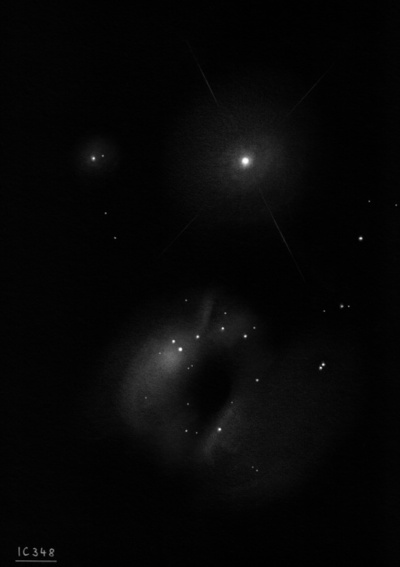
E.E. Barnard found IC 1985 on a plate taken 6 Dec 1893 at Lick Observatory. The IC position matches the brightest star in the IC 348 cluster. So, IC 1985 = IC 348.
400/500mm - 17.5" (12/16/95): IC 348 is an unusual object consisting of a scattered group of stars with associated nebulosity situated near a large dark cloud virtually devoid of stars. The cluster consists of 15 stars of varying magnitudes in a 6' group located 5'-10' S of Omicron = 38 Persei (V = 3.8). The brightest star in the group is mag 8.4 SAO 56680, which has two nearby companions and the group is clearly encased in a fairly bright reflection nebula, ~3' diameter. The star at the southwest end of the cluster is a nice close evenly matched double (∑437 = 9.8/10 at 11"). The immediate 50' low power field to the south is strangely devoid of almost all stars! (Barnard 3 and 4). Omicron also has a halo but this appears to be scattered light.
Notes by Steve Gottlieb
NGC 957
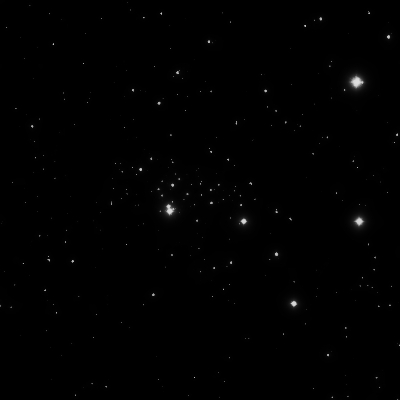
John Herschel discovered NGC 957 = h227 on 9 Dec 1831 and noted "a p rich, pL, cl; st 13...15; not compressed at the centre. Figure an irregular parallelogram."
200/250mm - 8" 30 stars in cluster, fairly large, moderately rich, elongated ~E-W, unresolved haze. A bright wide double star mag 8/10 at 23" is on the SE edge. Bracketed by fairly bright stars to the east and west. Located 1° NE of the Double Cluster.
400/500mm - 17.5" (10/25/97): moderately rich cluster, ~9'x4' in size and oriented ~E-W. Includes a mag 8 star (HD 15621) on the SW side and a mag 8/10 pair (h2143) on the SE end at 24" separation. About three dozen stars are fairly evenly distributed within this elongated cluster. There are few faint close double stars along the NE side and the bright double has a couple of much fainter companions. A mag 7.5 star is off the west side of the cluster but appears completely detached.
Notes by Steve Gottlieb
NGC 744
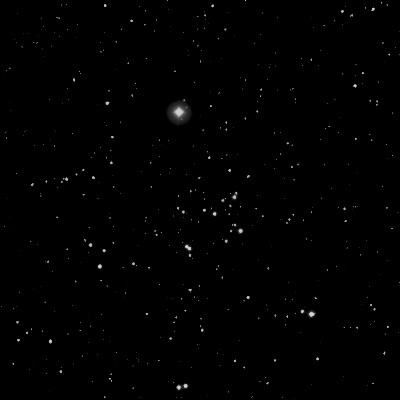
John Herschel discovered NGC 744 = h171 on 28 Nov 1831 and logged, "p rich, irr fig cluster of *s 11...13m, 8' dia." Sir Robert Ball, observing on the 72" on 29 Oct 1866, recorded "about 100 stars, more or less, of various sizes, scattered about, two of the 7th and the rest from the 8th mag down".
300/350mm - 13.1" (11/5/83): about two dozen stars in a 7' diameter including several fairly bright stars. The brightest is mag 7.8 SAO 22809 at the NNE edge. Pretty scattered appearance.
Notes by Steve Gottlieb
NGC 1245
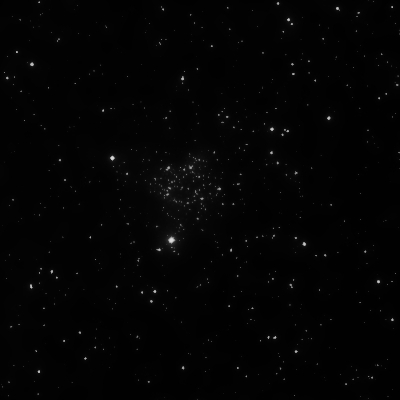
William Herschel discovered NGC 1245 = H VI-25 = h290 on 11 Dec 1786 (sweep 645), recording "a beautiful very compressed and rich cluster of small stars, about 8' or 9' diameter, irr R." On 30 Nov 1787 (sweep 786) he added "The large stars arranged in lines, like interwoven letters." John Herschel wrote on 31 Dec 1831 (sweep 390), "rich, L, cl not very comp; irreg R with stragglers; stars 12...15m; brightest part 5' diam".
On 23 Nov 1848, Johnstone Stoney (Lord Rosse's assistant) wrote, "Coarse, cl. strongly honey-combed. Would probably look annular with eccentric eyehole if it were far enough to be a nebula."
300/350mm - 13.1" (1/28/84): about 75 stars in a dense cluster. Includes bright stars on the north side.
400/500mm - 17.5" (12/8/90): about 100 stars at 220x in 10' diameter. Rich in mag 13.5-14 stars and includes four mag 12 stars along the west side. Roughly circular outline and uniform but no concentration to the center, many stars are arranged in lanes. A mag 8.5 star is off the south edge and a mag 9 star is about 5' off the ENE edge.
Notes by Steve Gottlieb
NGC 1513
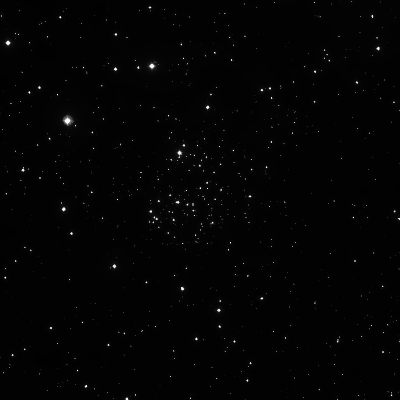
William Herschel discovered NGC 1513 = H VII-60 on 28 Dec 1790 (sweep 989) and recorded "A L cl of considerable L stars, pretty compressed and very rich, iR, about 7' dia." His position is accurate.
300/350mm - 13.1" (1/18/85): about 60 stars mag 11 and fainter over unresolved background glow. Located 50' SE of Lambda Persei (V = 4.3).
Notes by Steve Gottlieb
NGC 1023
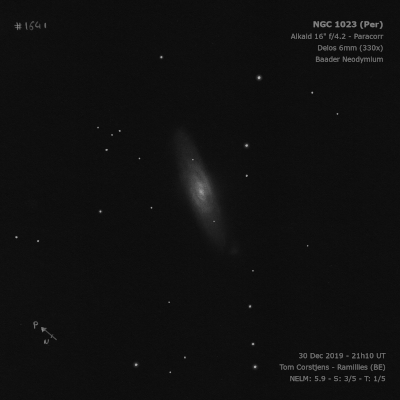
William Herschel discovered NGC 1023 = H I-156 = h242 on 18 Oct 1786 (sweep 618) and noted "eB, mE, a very BN, the branches losing themselves in the direction of the parallel nearly." On 17 Jan 1787 (sweep 692), he recorded "vB, gmbM to a very bright nucleus, mE nearly 10' long, from about 12? sp to nf." John Herschel sketched the galaxy in Oct 1828 and as well as Bindon Stoney on 27 Dec 1850 (included in plate XXV in Lord Rosse's 1861 publication).
200/250mm - 8" (11/8/80): fairly bright, bulging bright core, lens-shaped.
300/350mm - 13.1" (12/22/84): very bright, impressive, elongated ~E-W, bright core, stellar nucleus.
400/500mm - 17.5" (12/8/90): bright, large, very elongated 7:2 E-W, very bright core, almost stellar nucleus. A large fainter halo increases the dimensions to 7'x2'. Two 15th magnitude stars are superimposed on the east and west ends.
900/1200mm - 48" (10/25/11): this gorgeous galaxy appeared extremely bright, very elongated 4:1 E-W, ~7'x1.8', with a large, brighter central core that increases to an intensely bright inner core punctuated by a bright stellar nucleus. The outer halo gradually fades at the ends of the extensions. Several stars are superimposed on both sides of the core.
NGC 1023A = PGC 10139, a low surface brightness dwarf companion, is superimposed on the east side (2.4' ESE of center). It appeared as a faint, fairly large, low surface brightness patch oriented SSW-NNE, roughly 1.2'x0.8', and it blends into the main galaxy. Although most of the companion is within the halo of NGC 1023, part of it juts out the southeast edge of the galaxy. The halo of NGC 1023 extends beyond (east) of the dwarf.
Notes by Steve Gottlieb
NGC 1624
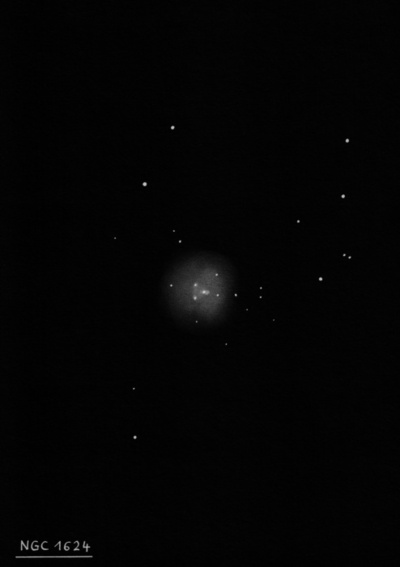
William Herschel discovered NGC 1624 = H V-49 on 28 Dec 1790 (sweep 989) and reported "6 or 7 small stars, with faint nebulosity between them, of considerable extent, and of an irregular form." G.P. Bond independently discovered NGC 1624 at Harvard College Observatory on 18 Feb 1851 with a 4" comet-seeker and reported it as a discovery.
300/350mm - 13.1" (12/22/84): fairly bright, round, compact glow surrounding a small group of at least five stars mag 11.8 and fainter using a UHC filter. The brightest cluster member (NGC 1624-2) and the principal source of ionization is the most magnetic massive star known with 35 solar masses and 20,000x the sun's magnetic field.
Notes by Steve Gottlieb
NGC 1333
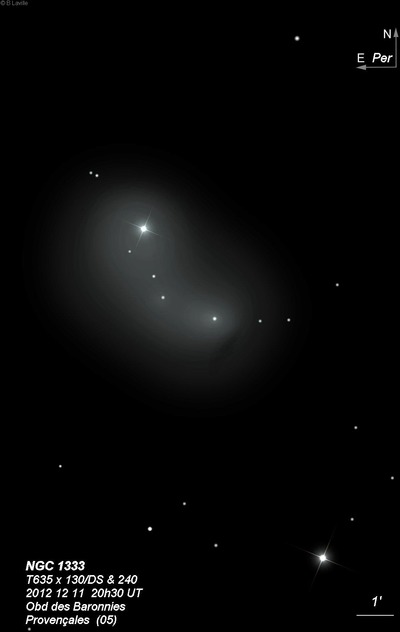
Eduard Sch?nfeld discovered NGC 1333 = Au 17 on 31 Dec 1855 with a 3-inch Fraunhofer refractor at Bonn Observatory, while measuring stars for the BD catalogue (NGC 1333 received the number BD +30? 548). He noted it as a nebulous star. The discovery was not announced until 1862 in AN 1391 and Auwers included it the same year as #17 in his "Verzeichnis neuer Nebelflecke" (list of new nebulae). In the meantime Horace Tuttle independently discovered the object on 5 Feb 1859 with a 3-inch comet-seeker and Bond (director of Harvard College) announced it as new in 1859MNRAS..19..224B: "it follows a star of the 9-10 mag by 6 seconds, and is 2' north of it. It is barely visible in a telescope of 3 in aperture."
In September 1862 d'Arrest noted it was as faint as a Herschel nebula of third class with the 11-inch refractor at Copenhagen, but since Tuttle's (independent) discovery was made using a 3-inch scope, he thought it might be a variable nebula (a popular topic among visual observers). Winnecke also took the view that it "must be a new one" as it was listed neither in the Slough catalogue nor Auwers' lists. Based on all the observations, Sch?nfeld reached the conclusion this case was a "...striking example of how the visibility of very faint, large diffuse nebulae depends on the magnification, air transparency and adaptation to the dark of the eye, so that, compared with ordinary fixed stars, aperture takes a back seat." In 1914 Barnard photographed the region at Yerkes Observatory and noted the nebula appeared "roundish and not symmetrical with respect to the star - its center seems to be several minutes to the south." Summarized from Harold Corwin's identification notes and Steinicke's "Observing and Cataloguing Nebulae and Star Clusters".
300/350mm - 13.1" (11/29/86): fairly bright nebula, large, extends SSW of a mag 9.5 star, oval, slightly brighter at the south edge.
400/500mm - 17.5" (2/9/02): bright, interesting reflection nebula at 140x. Apparently illuminated by a mag 10 star oddly offset at the NE end of the glow. The appearance is irregular; extending ~10'x6' SW-NE in the general direction of a mag 10 star 11' SW. The SW extension contains a couple of faint mag 14 stars and ends at a small, brighter knot that appears to surround a very faint star or stars. The field is oddly void of faint stars and there is a large starless region to the north (this is the dark nebula Barnard 2).
17.5" (12/8/90): fairly bright reflection nebula surrounds a mag 10 star that is offset to the northeast side of the nebula. This is a large object, about 10'x6' and elongated SW-NE. There is a bright knot in the southwest end. Two or three 15th magnitude stars are superimposed.
Notes by Steve Gottlieb
NGC 1491
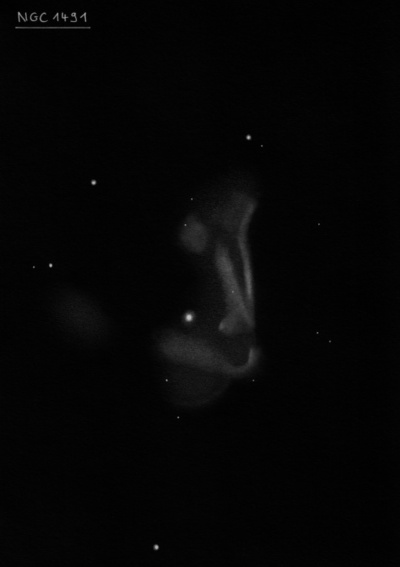
William Herschel discovered NGC 1491 = H I-258 on 28 Dec 1790 (sweep 989) and recorded "vB, iF, resolvable, bM, 5' l, 3 or 4' br. A pL star in it towards the following side, but unconnected." His position is fairly accurate, though Dreyer used a micrometric position of an involved star by Engelhardt. See Corwin's notes.
200/250mm - 8" (11/14/80): bright, large, ~6' diameter. A mag 10.5 star is at the east side.
300/350mm - 13.1" (1/18/85): bright emission nebula just west of a mag 10.5 star, extends SW-NE, interesting shape.
400/500mm - 17.5" (3/2/02): at 100x, this is a moderately bright, roundish glow, ~3' diameter. Extends mostly west of a mag 11 star, wrapping around the star, particularly on the north side. Excellent contrast gain with an OIII filter as it appears bright with an irregular surface brightness. There is a subtle bite cut out of the nebulosity on the east side that creates a darker hollow extending just west of the star. At 220x (unfiltered), about a half dozen stars are involved or at the edges. The nebulosity is quite irregular with a high surface brightness region preceding the star. Faint, elongated haze extends from this patch to the NE past the star giving an elongated appearance. A pair of mag 13-14 stars is at the northern end and another pair is just off the western edge.
17.5" (12/8/90): at 140x with OIII filter appears as a bright, moderately large, circular nebulosity involving a mag 11 star. The brightest portion lies to the west of the star and is elongated 3:2 ~N-S. There appears be a dark gap just west of the mag 11 star. Two very faint stars are superimposed near the edges.
Notes by Steve Gottlieb
NGC 1579
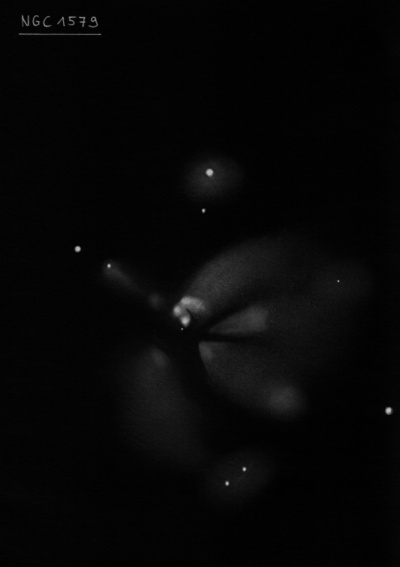
William Herschel discovered NGC 1579 = H I-217 = h315 on 27 Dec 1788 (sweep 899) and reported "pB, cL, mbM. Cometic. Stands nearly in the centre of a trapezium, 2 nf small stars pointing to it." John Herschel made three observations; in Nov 1827 (sweep 105) recording "pB; vL; irr R; it is inclosed among 6 stars, two of which point across its centre to a third. A * 7m precedes about 1 minute."
Samuel Hunter made a detailed sketch with the 72" on 13 Jan 1858 (fig. 8, plate XXV in LdR's 1861 publication). On 2 Nov 1850 Bindon Stoney logged "A faint patchy neby. follows the chief portion and also to the south. The chief portion is irregular in figure and I had the impression of a dark space intervening between it and the faint nebulosity."
200/250mm - 8" (12/6/80): faint nebulosity, diffuse.
300/350mm - 13" (1/18/85): fairly bright, circular, fairly small, appears brightest at the following edge. Forms an equilateral triangle with two mag 11.5-12 stars off the north and NE edges both 2' from center.
400/500mm - 17.5" (3/2/02): this bright reflection nebula appears nearly 5' in diameter with a prominent, slightly elongated 1.5' central region. The haze is irregular extending outward from this knot with the borders seemingly marked by a half-dozen stars situated around the periphery including a mag 11 star 2' N, a wide pair of mag 11.5-12 stars 1.6' and 2.3' NE and a pair of mag 13 stars ~2.5' S. Nebulosity extends mostly west and southwest of the central mass with a very faint piece to the south.
Notes by Steve Gottlieb
IC 2003
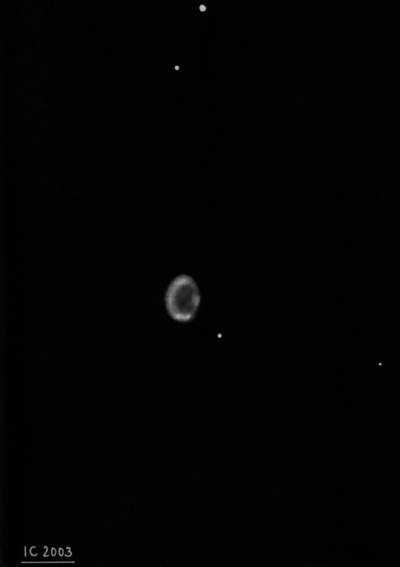
Rev. Thomas Espin discovered IC 2003 on 18 Jan 1907 with his 17.3-inch reflector while searching for new double stars. He estimated a diameter of 5" but the following measured measured a size of 6.9"x6.35" in PA 10.5°. This object is one of the final discoveries chronologically that made it into the IC II (Fleming found two new PN that year), and certainly the last visual discovery.
200/250mm - 8" (12/4/80): moderately bright, very small, just non-stellar at 125x and a definite disc is visible at 220x. A wide double star is 3' NE (9.5/11 at 47" oriented NW-SE).
400/500mm - 17.5" (3/1/03): easily picked up at 100x as a fuzzy blue-gray mag 11.5 star. Excellent view at 380x: bright, small, 10" diameter, irregularly round with an irregular surface brightness. There appears to be a knot (or offset central star?) on the SE side. A mag 13.7 star is just off the SW side [18" from center]. Located 3' SW of a wide mag 9.5/11 pair.
Notes by Steve Gottlieb
IC 351
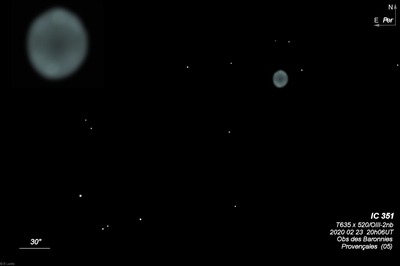
E.E. Barnard discovered IC 351 on 5 Dec 1890 with the 36-inch refractor at Lick Observatory, while examining the region near Comet Zona. He estimated a diameter of 4.6" and a magnitude of 10.5-11. Sherburne Burnham measured a diameter of 10".
Based on a Crossley photographs, Curtis (1918) described, "central star can be made out and is perhaps as bright as mag 14. The nebula shows a minute elliptical disk, which is 8"x6" in PA 10° in a 5 minute exposure. An elongated brighter patch is in the center."
200/250mm - 8" (12/4/80): fairly faint, very small, slightly elongated SW-NE. A wide trio of stars is about 3.5' SE consisting of mag 9 SAO 56707, a mag 10.5 star and a mag 12.5 star (separations of 32", 36" and 58").
400/500mm - 17.5" (3/1/03): swept up at 100x as a fuzzy mag 12 "star". Nice view at 380x, which reveals a moderate surface brightness 7" disk. Fairly evenly illuminated but the halo has a slightly irregular surface brightness. A mag 15 star is 20" WNW of center with a slightly fainter star further north. Located 3.4' NW of mag 9.5 SAO 56707. A mag 11 and 13 stars complete a trio to the SE.
17.5" (1/8/00): picked up at 100x as an out of focus mag 11 "star". At 220x, this high surface brightness PN was clearly nonstellar and slightly oval with a hint of a sparkle (central star) at the center. At 500x, appeared as a small, well-defined disc, elongated 4:3 SW-NE with dimensions ~7"x5". The quasi-stellar center was brighter with a small, fainter halo that seemed irregular. A couple of faint stars are close west and north. Located 3.5' NW of a distinctive trio of mag 10/11/13 stars.
Notes by Steve Gottlieb
NGC 884
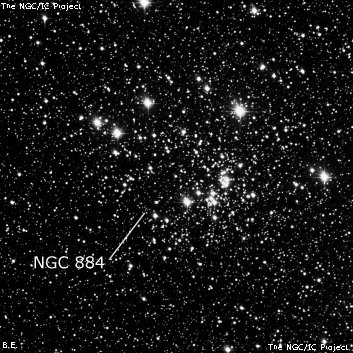
Hipparchus catalogued the Double Cluster about 130 BC and Ptolemy copied it into his Almagest: "At the tip of the right hand [of Perseus] and nebulous [or misty]." Giovanni Battista Hodierna (1654) resolved the double cluster into stars. William Herschel logged NGC 884 = H VI-34 on 1 Nov 1788 (sweep 877) as "A very beautiful, brilliant cluster of large stars irregularly round, very rich, near one-half degree in diameter." John Herschel noted on 9 Dec 1831 (sweep 387) that "a fine ruby star in the centre". The cluster was examined at Birr Castle looking for colored stars and five red stars were reported and one with a bluish tinge.
200/250mm - 8" this is the eastern component of the "double cluster". Very bright, large, very rich, ~20' diameter, ~60 stars, includes bright colored stars, many doubles.
400/500mm - 17.5" (10/25/97): the following group of the remarkable field of the "double cluster" is not as large or bright as NGC 869, but is centered around two wide triple stars. The central 5' has up to 50 stars including a number of faint mag 14-15 stars forming a rich background. Off the west end of the central region is a long string of stars which heads NE for 10' towards 3 brighter stars and then turning south and heading back past mag 8 orange-red RS Persei. The 20' field includes ~200 stars, although the cluster includes fewer bright stars as NGC 869 and is less compressed.
Notes by Steve Gottlieb
NGC 1444
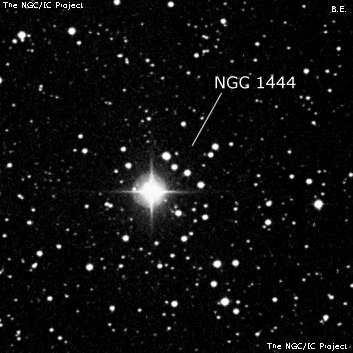
William Herschel discovered NGC 1444 = H VIII-80 = h308 on 18 Dec 1788 (sweep 894) and recorded "a cluster of small stars, containing one large one, 9-10 mag; 2 or 3' diam. not rich." On 8 Nov 1831 (sweep 384), John Herschel logged a "cluster of about 20 st; place that of a superb double star (? 446); the rest 12m."
200/250mm - 8" (1/1/84): consists of a mag 7.5 star with 7 faint stars just west. The brightest star is ?446 = 7.5/9.0 at 10".
400/500mm - 17.5" (11/2/91): at 220x, about 20 mag 7-14 stars scattered in a 5' diameter, not rich or impressive. The group mainly consists of a bright double star (?446 = 7/9 at 9") with a third fainter mag 13 star 12" NE of the bright mag 7 star. Close northwest is a line of four mag 10-12 stars oriented SW-NE.
The bright star (B-type HD 23675) is a member of the Cam OB1 Association in a dusty portion of the Milky Way, but the "cluster" may be an unrelated group of field stars.
Notes by Steve Gottlieb
NGC 1582
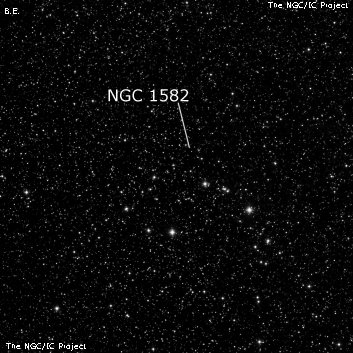
William Herschel discovered NGC 1582 = H VIII-70 on 3 Feb 1788 (sweep 801) and logged "a cluster of coarsely scattered large stars, pretty rich, 20 or 25' diameter."
400/500mm - 18" (11/26/03): at 115x, appears a very large, scattered field with a number of brighter stars. There are no denser regions of fainter stars to distinguish this as a cluster although the star density drops rapidly to the west (edge of Milky Way?). Most distinctive is a stream of bright stars which extends 20' SW of the cluster's position and includes a number of mag 8-10 stars. The string begins with mag 8.7 SAO 39581 and includes a 16" pair of mag 10 stars as well as mag 8.6 SAO 39578. The classification of this group as a true cluster is doubtful.
Notes by Steve Gottlieb
NGC 1496
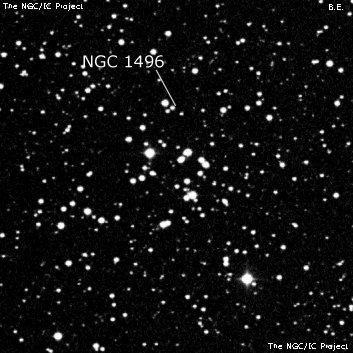
John Herschel discovered NGC 1496 = h310 on 8 Nov 1831 (sweep 384) and recorded a "curious knot of stars forming a cluster in form the segment of an elliptic ring." His position and and description accurates describes this cluster.
400/500mm - 17.5" (12/28/94): 20 stars mag 12-15 in a 5' region elongated E-W. The stars are mainly arranged in a semicircle open to the east with several nice close pairs! The brightest mag 11 star is on the NE end of the semicircle and the SE end is a very close double. An isolated mag 10 star is 4' SW and 0.8' NE of this star is an evenly matched mag 14 pair at 7" separation.
Notes by Steve Gottlieb
NGC 1003
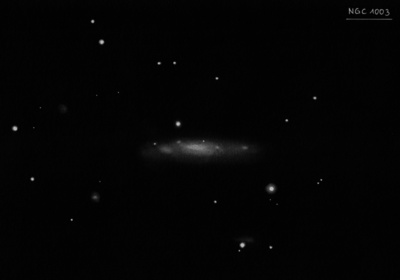
William Herschel discovered NGC 1003 = H II-238 = H III-198 = h240 on 6 Oct 1784 (sweep 283) and noted "Suspected, but the haziness will not permit to verify it." On 17 Oct 1786 (sweep 614), he logged "pB, mE nearly in the parallel, mbM, near 4' long and about 1' br." On the following night (sweep 618) he logged "cB, mE, vgmbM, near 4' l." The two H-designations were combined in the GC and NGC (suggested by Marth).
300/350mm - 13.1" (12/22/84): moderately bright, elongated ~E-W, weak concentration. A mag 13 star is on the NE edge 0.8' from center. An extremely faint knot is at the NW edge.
400/500mm - 17.5" (11/1/86): moderately bright, elongated 3:1 WNW-ESE, bright core. A mag 13 star is involved at the NE side, just 0.8' from center. Located 2' NE of a mag 10 star.
Notes by Steve Gottlieb
IC 284
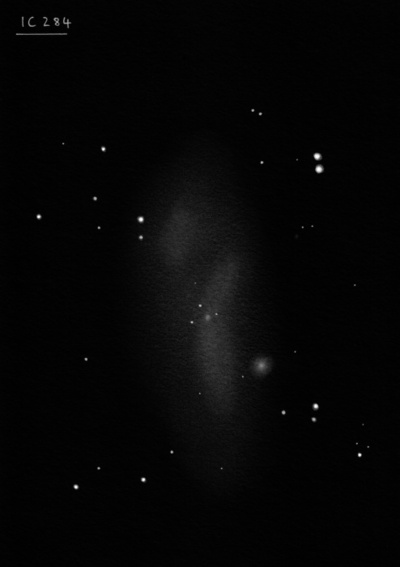
Lewis Swift discovered IC 284 = Sw. VIII-13 on 27 Oct 1888 with the 16" refractor at Warner Observatory. He noted "eeF, pL, lE, D * np, bet 2 st". His position is 12 sec of RA west of UGC 2531 but the comment "D * np" pins down the identification.
400/500mm - 17.5" (10/24/87): faint, moderately large, diffuse, elongated 2:1 SSW-NNE, gradually increases to a small bright core. A mag 11 double at 16" separation is 2.5' NW. Located 18' E of NGC 1175.
600/800mm - 24" (1/25/14): at 200x and 375x appeared moderately bright, large, elongated 2:1 SSW-NNE, at least 3'x1.5', weak concentration to a brighter core. Two mag 15 stars are superimposed on the east edge of the core. V Zw 319 = PGC 11646 is on the southwest edge of the halo, 0.7' SW of center! The companion appeared very faint, round, only 12" diameter. A 17" pair of mag 11.5 stars lies 2.5' NW. IC 288 lies 15' E.
NED has no distance info on V Zw 319, though there is no indication of interaction on the SDSS and an arm from IC 284 is silhouetted on V Zw 319, indicating it may be a background object.
Notes by Steve Gottlieb
NGC 1265
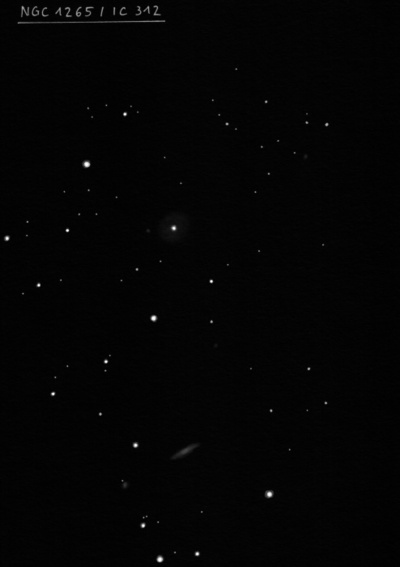
Guillaume Bigourdan discovered NGC 1265 = Big. 20 on 14 Nov 1884 and reported "mag 13.3, 15" diameter, slbM." His position is 5 tsec of RA east and 1.4' south of UGC 2651 = PGC 12287.
In January 2017 I wrote Harold Corwin regarding my observation: "[I] initially was stumped on NGC 1265. It took me a minute or two to notice NGC 1265 as a relatively large, diffuse glow surrounding a fairly bright star that is superimposed. The star is not evident on the DSS, but you can clearly see it on the SDSS, including its diffraction spikes. NGC 1265 supposedly has a V mag ~12, but I'm guessing that includes the star, and the glow of IC 312 at V = 13.4 was more obvious to me."
Corwin checked Bigourdan's records and found he misplaced his offset star by 8'. Once corrected, his offset points to IC 312! Although the 8 arcminute error is unexplained, Corwin concludes "it is clear that Bigiourdan discovered IC 312 and not UGC 2651." Although he has updated his files to this identification, it will be difficult to change other databases and the literature on the Perseus galaxy cluster.
400/500mm - 17.5" (1/7/89): very faint, small, round glow. This member of the AGC 426 cluster is located just east of a mag 11 star and has a striking location. Forms a pair with IC 312 6' SSW.
Note: The bright star is directly superimposed, so there was some confusion in this observation.
Note: In 2017 it was determined that based on the historical record NGC 1265 = IC 312 (description below) and the traditional identification NGC 1265 = UGC 2651 is incorrect.
600/800mm - 24" (1/28/17): at 282x; large, very diffuse glow with a bright star superimposed just east of center! This galaxy appeared as a low surface brightness haze perhaps 1.25' in diameter. With careful viewing, there appeared to be a very small, slightly brighter core just west of the star. A mag 10.4 star lies 2.7' S. IC 312 lies 6' SSW.
24" (1/28/17): at 282x; moderately bright, fairly small, oval 3:2 NW-SE, 0.6'x0.4', small bright core. PGC 12288, just 1.9' SE, appeared faint, small, elongated ~3:1 SSW-NNE, ~20"x7". A mag 14-14.5 star is at the northeast end. NGC 1265, a low surface brightness galaxy with a bright star superimposed, lies 6' NNE of IC 312.
Notes by Steve Gottlieb
NGC 1160
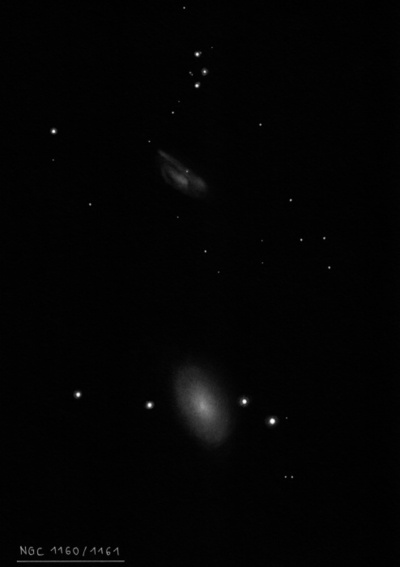
William Herschel discovered NGC 1160 = H III-199 = h277, along with NGC 1160, on 7 Oct 1784 (during sweeps 281-285, carried out in the east) and reported "the first of 2 [with NGC 1161]. vF, iF, pS." On 11 Dec 1786 (sweep 645), he logged "pB, iR, mbM, about 1' in diam." and measured separate positions for the two objects.
JH measured an accurate position for NGC 1161 and noted the wide double star off the west side, but has no entry for NGC 1160 and it was not found by d'Arrest. So, the observers at Birr Castle assumed NGC 1160 was a new discovery and the two galaxies have three entries in the GC. Dreyer staightened this out before the publication of the NGC, while an observing assistant at Birr Castle. Surprisingly, NGC 1160 was sketched by Dreyer and clearly shows the southern spiral arm.
400/500mm - 17.5" (10/24/87): fairly faint, fairly small, oval 2:1 SW-NE, broad concentration, diffuse halo. A trio of mag 12-13 stars lie 1.5'-2' N. Forms a pair with NGC 1161 3.5' S.
Notes by Steve Gottlieb
UGC 2489
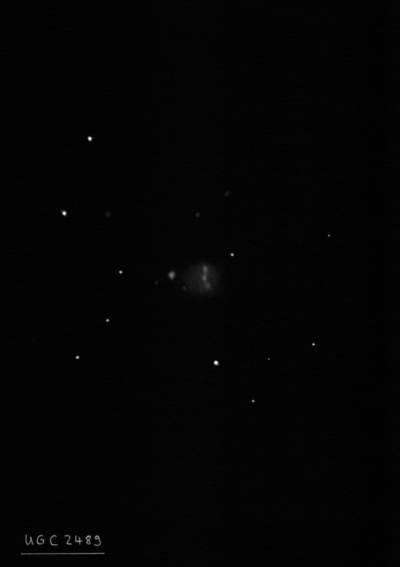
400/500mm - 17.5" (1/9/99): this member of AGC 407 appears as a faint, diffuse, elongated glow with an irregular surface brightness, ~1' in length. Described in the UGC as a compact group of 7 galaxies. The combined glow of these galaxies is both larger and more prominent than UGC 2493 5.7' SSE which is the brightest individual galaxy in AGC 407.
600/800mm - 24" (2/8/18): the main glow of Zwicky's Nonet appeared faint, small, slightly elongated, ~20" diameter. I couldn't confidently resolve the two components G1 (B) and G3 (D) within this glow. However, ~20" E is G7 (G), which was occasionally visible (V = 15.6, B = 16.7) and separated from the main glow. It was difficult to determine if it appeared nonstellar, but it was certainly 6" or less in size.
The designations are from the 2017 paper "Zwicky's Nonet: a compact merging ensemble of nine galaxies and 4C 35.06, a peculiar radio galaxy with dancing radio jets" and the 1982 paper by Schneider and Gunnl: "V Zw 311 - The once and future cD", respectively.
Notes by Steve Gottlieb
IC 275
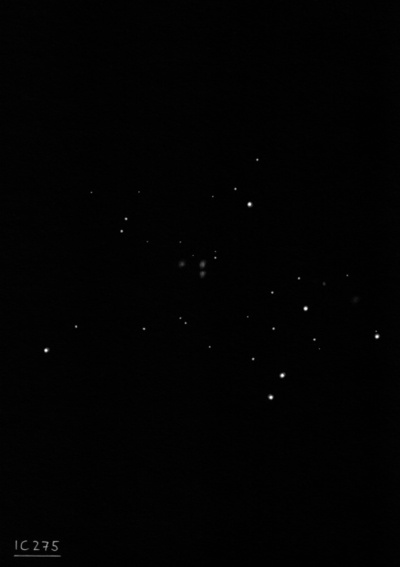
Lewis Swift discovered IC 275 = Sw. VIII-9 on 31 Oct 1888 and recorded "eeeF; pS; R; F * nr p; D * nr sp; bet. 3 st.; f of 2 [with IC 274]." His position matches V Zw 309, a triple system, with the brighter two components forming a 15" pair oriented N-S. Although the three components are listed in the PGC (from V Zw 309), neither HyperLeda nor SIMBAD labels any of the 3 as IC 275. Swift's "Double * near south-preceding" may be a ~30" pair ~2.5' SW
600/800mm - 24" (12/12/17): at 375x; faint, fairly small, roundish, ~24" diameter, low irregular surface brightness. IC 275 is a triple system with the two closer components (IC 275 NED1 and NED2) separated by 15" N-S. I was confident that 2 or 3 extremely faint stellar or quasi-stellar nuclei were glimpsed and made a diagram of the orientation. Checking the SDSS at home, my diagram matches NED2 (north) and NED2 (south), along with a mag 15.8 star 18" NW of NED 2. I apparently missed IC 275 NED3, which is 30" E of NED2 and probably the faintest of the trio.
Notes by Steve Gottlieb
Abell 426
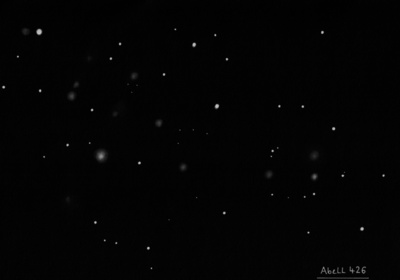
| Type | GALCL [20II-III] |
| RA | 03:19:42.0 |
| Dec | +41:30:00.0 |
| major_axis | 190.4' |
| mag | 13.0 |
BV 3
| Type | PN |
| RA | 01:53:03.4 |
| Dec | +56:24:17.0 |
| major_axis | 24.0'' |
| mag | 14.2 |
| surface_bright | 11.9 |
